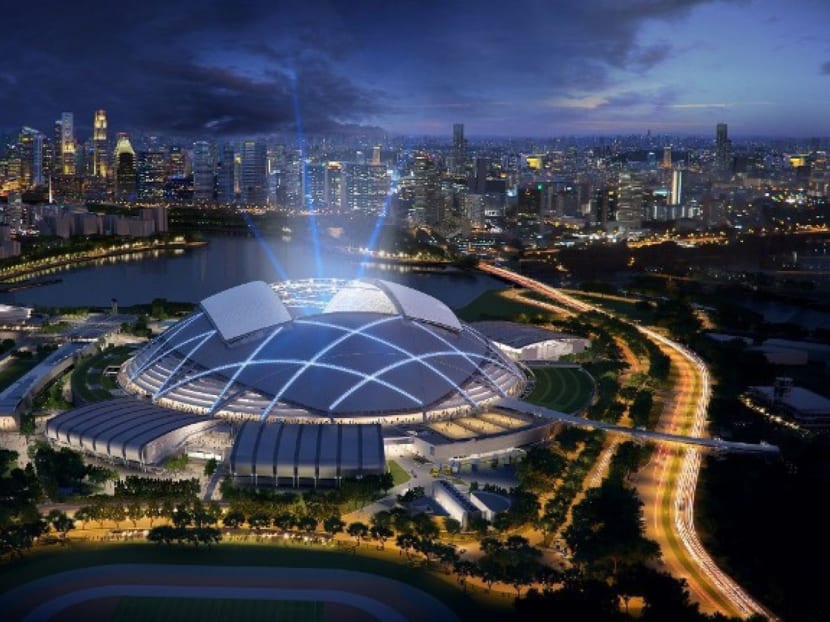Merlion Cup could return to S’pore in January
SINGAPORE — After a seven-year hiatus, the Merlion Cup — an invitational football tournament — could make its return to Singapore in January next year.

The Merlion Cup is expected to be held at the 55,000-seater National Stadium at the Sports Hub. Photo: Singapore Sports Hub
SINGAPORE — After a seven-year hiatus, the Merlion Cup — an invitational football tournament — could make its return to Singapore in January next year.
TODAY understands that leading international media rights company MP & Silva is currently in discussions to bring the Myanmar national team and Chinese outfit Shanghai Shenhua. Another team to be added to the mix could be J.League side Yokohama Marinos.
While details of the Cup have not yet been confirmed, it is expected to be held at the 55,000-seater National Stadium at the Sports Hub.
The last edition of the tournament was held in 2009, when a Liverpool side containing Fernando Torres, Jamie Carragher and Dirk Kuyt beat Singapore 5-0 in a one-off match at the old National Stadium in Kallang to lift the trophy.
The potential return of the Merlion Cup comes as a byproduct of a six-year partnership worth more than S$25 million between the Football Association of Singapore (FAS) and MP & Silva, which was inked earlier this year.
In response to media queries, a MP & Silva spokesperson said: “We’re not able to confirm anything at the moment as details have yet to be finalised. We are in discussions with a number of teams and hope to share more information when ready.”
FAS president Zainudin Nordin had also previously expressed his intention to bring back the competition — which was held annually from 1982 to 1986, and once in 1992 — during the FAS annual general meeting in 2013.
Despite its status as an “exhibition tournament”, former Singapore international R Sasikumar believes playing in the competition will prove beneficial for the national team, as well as provide a window of opportunity for players to showcase their talents to more illustrious clubs.
“Having this tournament is good for the industry, and good for Singapore football in general,” said Sasikumar. “This way, the national team will be able to play more matches as well, because they generally do not get much game time as a team outside of the usual tournaments like the Suzuki Cup.
“In addition, this will give national players an opportunity to put themselves in the shop window. If they do well against the teams that take part, they might just earn themselves a contract with the club as well. So from that perspective, it’s great for the players.”
Former national defender Razali Saad, who took part in the Merlion Cup in 1985 when the Lions finished joint champions with the Yugoslav Olympic team, added: “It’s beneficial for the players in terms of exposure, because they’ll be going up against different teams from around the world. This will give them a chance to learn from varying styles of play and allow them to go up against different types of players.”
However, Sasikumar believes the lukewarm spectator attendance at the national team’s recent matches during their World Cup qualifiers — a total of about 17,000 fans turned up for the two matches against Afghanistan and Cambodia — and the cost of holding the tournament (the commercial rate could be about S$150,000 to S$200,000 per game) could see MP & Silva struggling to fill up the National Stadium should the Merlion Cup take place.
“The cost of hosting an event in Singapore is ridiculous,” explained Sasikumar, who is also the managing director of Red Card, the company which organised this year’s Lion City Cup. “So the challenge is that it’ll be hard to sustain the event. There’s some nostalgia behind the Merlion Cup, and we don’t want it to happen just as a one-off.
“An event is only a success if there’s interest in it. But just going by the last couple of weeks in terms of crowd attendance during the World Cup qualifiers, you can see the stadium was not close to being full.
“Maybe it’s because of the high ticket prices for the matches, so it’s important for the organisers to ensure that enough research is done on the consumption pattern of audiences as well.”





